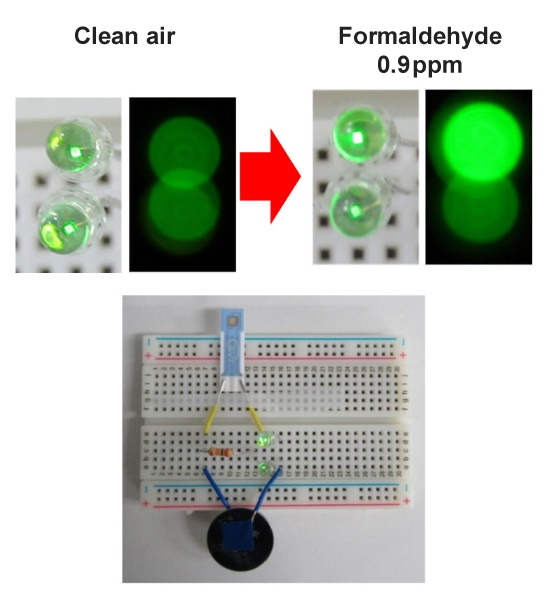Compact Sensor Capable of Repeatedly Detecting Formaldehyde
—The Technology May Be Applicable to the Development of Continuous Formaldehyde Monitoring Systems to Prevent Sick Building Syndrome—
2017.10.23
National Institute for Materials Science (NIMS)
National Institute of Advanced Industrial Science and Technology (AIST)
NIMS and AIST jointly developed a compact sensor capable of continuously monitoring formaldehyde, a cause of sick building syndrome.
(“Amperometric Detection of Sub-ppm Formaldehyde Using Single-Walled Carbon Nanotubes and Hydroxylamines: A Referenced Chemiresistive System”, Shinsuke Ishihara, Jan Labuta, Takashi Nakanishi, Takeshi Tanaka, and Hiromichi Kataura; ACS Sens., 2017, 2 (10), pp 1405–1409 DOI: 10.1021/acssensors.7b00591)
Abstract
- NIMS and AIST jointly developed a compact sensor capable of continuously monitoring formaldehyde, a cause of sick building syndrome. While conventional formaldehyde sensors generally require detection tag replacement after each measurement, the newly developed sensor can continuously monitor formaldehyde without replacement. This is because the electrical conductivity of the new sensor material—which changes when exposed to formaldehyde—is able to return to its original level again by exposing it to clean air. A continuous formaldehyde monitoring system may be developed by integrating the sensor with a smartphone, etc.
- Formaldehyde—which is used as a construction material preservative—is known to cause health problems (sick building syndrome) and is a suspected carcinogen. The World Health Organization recommends that indoor concentrations of formaldehyde not exceed 0.08 ppm (note: 1 ppm = a micro liter volume of a chemical in one liter of air). Continuous monitoring of formaldehyde had been inconvenient due to the need for large, expensive sensors or the necessity of replacing detection tags after each measurement when small sensors are used.
- The joint research group developed a sensor material comprised of carbon nanotubes—a type of nanomaterial—capable of repeatedly detecting formaldehyde. The conductivity of carbon nanotubes with semiconductive properties increases when they react with acidic gases. Although formaldehyde is a neutral compound, some chemical reagents are available that produce an acidic gas upon reaction with formaldehyde. Thus, the group combined the sensor material with the chemical reagents, thereby enabling the conductivity of the carbon nanotubes to increase in response to formaldehyde. The group measured changes in the conductivity of the sensor material using an ohmmeter and found the material to be highly sensitive to formaldehyde, able to detect formaldehyde concentrations as low as 0.016 ppm. In addition, the group confirmed that the sensor material can be used repeatedly by exposing the sensor to clean air, thereby removing the acidic gases generated.
- The research group created a small test device capable of continuously monitoring formaldehyde by combining the sensor material with two light-emitting diodes (LEDs) and connecting only one of the LEDs to the material. When the sensor was exposed to formaldehyde, its conductivity increased, which brightened the connected LED. Comparing the relative brightness of the two LEDs enabled detection of formaldehyde at concentrations as low as 0.9 ppm.
- The newly developed sensor material can easily be combined with widely used electronic devices, such as smartphones. The fusion of the sensor technology with information and communications technology may enable remote, real-time detection of formaldehyde, thereby making society safer and more secure.
- This research project was conducted jointly by a NIMS research group led by Shinsuke Ishihara (Senior Researcher, Frontier Molecules Group, International Center for Materials Nanoarchitectonics) and AIST’s Nanomaterials Research Institute. This study was published in the online edition of ACS Sensors, a journal of the American Chemical Society, on October 16, 2017, local time.

Simple sensor capable of detecting formaldehyde
Related files
- MANA
Contacts
(Regarding this research)
-
Shinsuke Ishihara
Senior Researcher, Frontier Molecules Group,
International Center for Materials Nanoarchitectonics (MANA)
National Institute for Materials Science (NIMS)
Tel: +81-29-860-4602
E-Mail: ISHIHARA.Shinsuke=nims.go.jp
(Please change "=" to "@")
(For general inquiries)
-
Public Relations Office, Planning Division
National Institute for Materials Science
1-2-1 Sengen, Tsukuba, Ibaraki, 305-0047, Japan
Tel: +81-29-859-2026
Fax: +81-29-859-2017
E-Mail: pressrelease=ml.nims.go.jp
(Please change "=" to "@")
